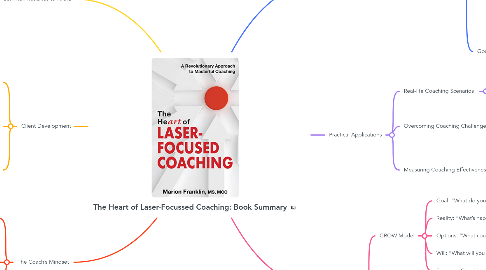
1. Common Mistakes to Avoid
1.1. Over-advising
1.1.1. Mistake: Slipping into consultant mode
1.1.2. Solution: Redirect—“What do you think would work best?”
1.2. Lack of Clarity
1.2.1. Mistake: Leaving sessions without clear outcomes
1.2.2. Fix: “What’s your key takeaway today?”
1.3. Ignoring Emotional Cues
1.3.1. Mistake: Focusing solely on logic
1.3.2. Approach: “I noticed your tone shifted—what’s coming up for you right now?”
2. Client Development
2.1. Empowering Clients
2.1.1. Focus: Ownership over decisions
2.1.2. Example: Asking, “What approach feels right for you?” instead of giving advice
2.1.3. Key Quote: “A client’s breakthrough belongs to them—that’s the power of coaching.”
2.2. Accountability Structures
2.2.1. Techniques: Clear next steps, regular check-ins
2.2.2. Example: “What will you do by Friday? How will you know you’ve succeeded?”
2.3. Sustaining Motivation
2.3.1. Approach: Revisit purpose and intrinsic motivators
2.3.2. Example: “Why does this goal matter to you beyond the surface?”
2.3.3. Key Quote: “Motivation fades when meaning is forgotten.”
3. The Coach’s Mindset
3.1. Being Non-judgemental
3.1.1. Practice: Suspend assumptions, focus on curiosity
3.1.2. Key Quote: “Coaching isn’t about having the answers; it’s about honouring the client’s answers.”
3.2. Growth-oriented Thinking
3.2.1. Belief: Every challenge is an opportunity for growth
3.2.2. Example: Helping clients see failure as feedback
3.2.3. Key Quote: “A coach’s greatest power is belief—in the client’s potential, even when they doubt it.”
3.3. Self-awareness
3.3.1. Reflection: “Am I coaching or consulting right now?”
3.3.2. Practice: Supervision, journaling, peer feedback
4. Core Principles of Coaching
4.1. Active Listening
4.1.1. Definition: Fully engaging with the client, understanding beyond words
4.1.2. Techniques: Paraphrasing, reflecting feelings, minimal encouragers (“Tell me more about that”)
4.1.3. Example: Summarising a client’s dilemma, e.g., “It sounds like you’re feeling stuck because you’re unsure which direction aligns with your values.”
4.1.4. Key Quote: “Listening isn’t waiting to speak; it’s creating space for the client to hear themselves think.”
4.2. Powerful Questioning
4.2.1. Purpose: Unlocking new perspectives, challenging assumptions
4.2.2. Examples:
4.2.2.1. “What’s possible that you haven’t considered yet?”
4.2.2.2. “If success was guaranteed, what would you do differently?”
4.2.3. Key Quote: “The best coaching questions don’t solve the problem—they reveal it.”
4.3. Goal Setting
4.3.1. Approach: Focus on clarity, specificity, and motivation (SMART goals)
4.3.2. Example: Reframing vague goals to specific actions, e.g., “Deliver a confident 10-minute presentation by next month.”
4.3.3. Key Quote: “A vague goal leads to vague results.”
5. Practical Applications
5.1. Real-life Coaching Scenarios
5.1.1. Example: Coaching an overwhelmed manager—reframing “I have no time” to “How am I prioritising my time?”
5.2. Overcoming Coaching Challenges
5.2.1. Common Issues: Resistance, e.g., “I’ve tried everything.”
5.2.2. Solution: Reframing—“What’s one thing you haven’t explored deeply?”
5.2.3. Key Quote: “Resistance isn’t refusal; it’s fear in disguise.”
5.3. Measuring Coaching Effectiveness
5.3.1. Tools: Assessments, reflection journals, feedback loops
5.3.2. Example: Tracking leadership confidence scores pre- and post-coaching
6. Techniques
6.1. GROW Model
6.1.1. Goal: “What do you want to achieve today?”
6.1.2. Reality: “What’s happening right now?”
6.1.3. Options: “What could you do differently?”
6.1.4. Will: “What will you commit to doing next?”
6.1.5. Example: Coaching a leader struggling with delegation—exploring reluctance, identifying tasks, setting commitments.
6.2. Feedback Methods
6.2.1. Principles: Timely, specific, constructive
6.2.2. Example: “I noticed your pauses were effective. Consider varying your tone for engagement.”
6.2.3. Key Quote: “Feedback isn’t criticism; it’s a gift of clarity.”
6.3. Building Rapport
6.3.1. Techniques: Mirroring language, authentic empathy, consistency
6.3.2. Example: Matching communication style to create trust without mimicking
6.3.3. Key Quote: “Rapport isn’t about being liked; it’s about being trusted.”
